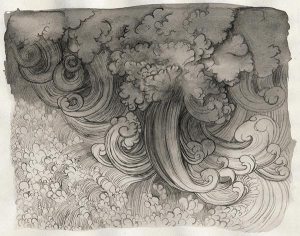
In a forum thread we were discussing cobalt teal and I posted this photo of various cobalt blue pigments in oil paint, which I thought I’d share here too. I can’t guarantee color accuracy in the photo, but I think it’s close.
Regular cobalt blue is normally made from the pigment PB28 and it’s a good, but often expensive, middle blue. It dries fast because of the cobalt content. Compared to ultramarine it’s a little more opaque and has a little less red while being lighter in masstone. Although this particular pigment is called by the name cobalt blue, all of the above paints contain cobalt. The difference between them being which other metals are included, such as aluminum or chromium, and in what amounts.
There’s two pigments that are labeled as cobalt teal by the paint makers that offer them. One is an uncommon and very opaque teal version of the standard cobalt blue pigment, PB28, and the other is a teal version of one of the cobalt greens, PG50. They’re similar enough that if you have one you won’t need the other. I almost never see other artists talk about having teals like these on their palette, so they must not be popular. I think they can be useful for painting green hills far in the distance, and definitely tropical water, but until now I’ve also rarely used them myself.
PB36 is another pigment that comes in a large range of varieties. Although it’s not the original cerulean blue, PB36 can be so close to the original in appearance that it’s often given the name cerulean. At the other end of its range are blue turquoise and green turquoise varieties. Shown here is a green turquoise. I like the turquoise color, but again I rarely use it.
The original cerulean is PB35. It typically dries to a more matte surface. Either this or the PB36 version labeled as cerulean would be good for painting skies, especially closer to the horizon where the sky has more green, as they are both slightly greener than cobalt blue. I actually prefer the PB36 version of cerulean because the color has a little more intensity to it. The name cerulean probably comes from the Latin word for heaven or sky.
Lastly, in the right column I mixed all of these with an equal amount of nickel titanate yellow, which is a somewhat dull lemon yellow, to see how they’d behave.

I so love your explorations